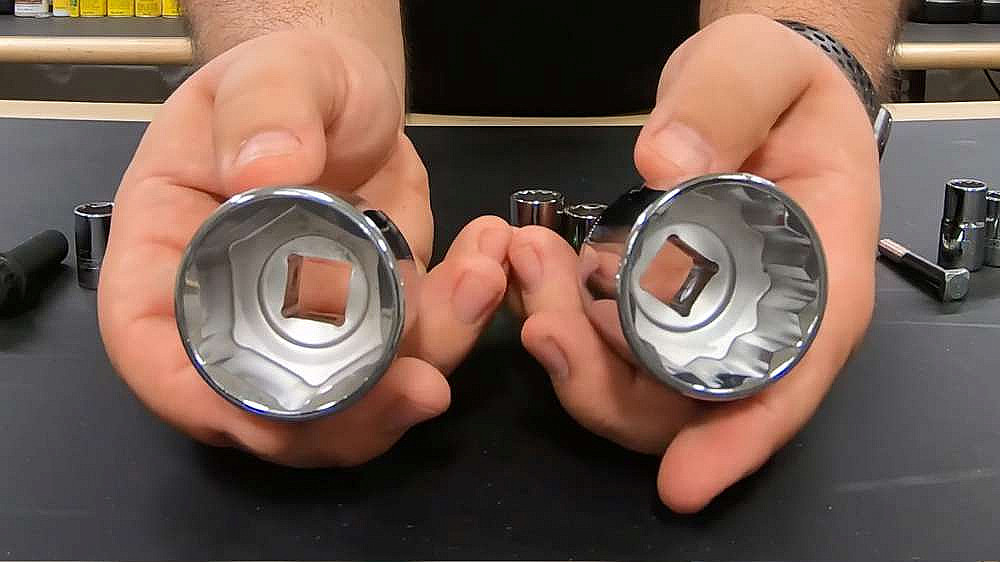When you’re working on your car or tackling a DIY project, choosing the right tools is crucial. You might find yourself wondering: should you go with a 12 point socket or a 6 point socket?
It’s a decision that could save you time, effort, and even prevent damage to your nuts and bolts. This is more than just a choice; it’s about optimizing your toolkit for efficiency and effectiveness. Imagine the satisfaction of completing a task with ease, knowing that you have the right tool in your hand.
By understanding the key differences and benefits of each socket type, you can make informed decisions that will enhance your work experience. Dive into the details, and soon you’ll see how this seemingly simple choice can have a big impact on your projects. Stay with us as we unravel the mystery behind these essential tools, ensuring your next job is a breeze.

Credit: www.youtube.com
Socket Basics
Understanding the difference between a 12-point socket and a 6-point socket helps in selecting the right tool. A 12-point socket offers more angles and fits tighter spaces, while a 6-point socket provides a stronger grip for heavy-duty tasks. Choose based on the task’s requirements for effective results.
When it comes to tackling DIY projects or professional mechanical tasks, understanding the basics of sockets is crucial. Whether you’re fixing a car or assembling furniture, using the right tools can make all the difference in efficiency and effectiveness. Let’s dive into the world of sockets and explore what makes them essential in your toolbox.What Is A Socket?
A socket is a tool used to tighten or loosen fasteners such as nuts and bolts. It attaches to a wrench or ratchet, providing the grip needed to turn these fasteners. Think of it as an extension of your hand, multiplying your strength and precision. Sockets come in various sizes to fit different fasteners. They are usually made of durable materials like chrome vanadium steel to withstand high torque and resist wear. Have you ever tried using the wrong size socket and ended up stripping a bolt? It’s a common frustration that highlights the importance of choosing the right socket.Types Of Sockets
There are several types of sockets, each designed for specific tasks. The most common are the 6-point and 12-point sockets. 6-point sockets are shaped like a hexagon. They provide a snug fit on fasteners, reducing the risk of rounding them off. This makes them ideal for high-torque applications. 12-point sockets, on the other hand, have double the contact points. They can fit over square fasteners and are easier to position in tight spaces. However, they might not grip as firmly on stubborn fasteners as their 6-point counterparts. Choosing between a 6-point and a 12-point socket often depends on the task at hand. For heavy-duty jobs, a 6-point socket can be your best friend. But if you’re working in cramped quarters, a 12-point socket might be the hero you need. Next time you reach for a socket, consider the type of job you’re doing. Are you working in a tight spot or dealing with a tough bolt? Your answer can guide your choice, ensuring you have the right tool for the job.Design Differences
When it comes to working with sockets, understanding the design differences between a 12 point socket and a 6 point socket can make a significant impact on your projects. Each design has its own unique advantages. Knowing these can help you choose the right tool for your needs. Whether you’re a DIY enthusiast or a professional mechanic, the subtle distinctions can influence your efficiency and success.
12 Point Socket Design
The 12 point socket design is characterized by its double hexagonal shape. This allows it to fit over a wider variety of fasteners. It’s especially useful in tight spaces where you might need more angles for turning.
Have you ever struggled with a bolt that just wouldn’t budge? The 12 point socket can save the day by offering more contact points. This can be a game-changer when dealing with worn or rounded bolts.
However, there’s a trade-off. More contact points can mean less grip on the fastener. It might slip under high pressure. Consider this before you choose a 12 point socket for heavy-duty tasks.
6 Point Socket Design
The 6 point socket design is simpler, resembling a standard hexagon. It provides a snug fit around fasteners. This design is known for its strength and durability.
Imagine you’re trying to loosen a stubborn bolt. The 6 point socket provides maximum grip, reducing the risk of slipping. It’s ideal for high torque applications where you need reliability.
Have you ever wondered why professionals often prefer 6 point sockets? Their strong grip minimizes the risk of damaging fasteners. This can be crucial when working with delicate or precision parts.
Choosing between a 12 point and a 6 point socket boils down to your specific needs. Are you dealing with tight spaces or high-pressure situations? Each design offers unique benefits. What’s your preference?
Performance And Efficiency
Performance and efficiency are key factors in choosing between a 12 point socket and a 6 point socket. Each type offers unique benefits in various applications. Understanding these differences can help in selecting the right tool for your needs.
Torque Application
A 6 point socket grips the bolt head tightly. This design reduces the chance of slipping. It applies torque more effectively. Especially in high-torque situations, the 6 point socket excels. It fits snugly over the fastener, maximizing grip.
The 12 point socket offers more contact points. It works well in tight spaces. It also provides flexibility in aligning the tool with the fastener. This can be useful in low-torque applications. The 12 point socket allows quicker and easier alignment.
Strength And Durability
Strength is crucial for socket longevity. The 6 point socket is typically stronger. Its design reduces stress on the socket walls. This makes it less prone to wear. It handles heavy-duty tasks with ease.
The 12 point socket is versatile. It offers moderate strength and durability. It’s suitable for light to medium tasks. Its design allows use on square and hexagonal fasteners. This adds to its versatility.
Usage Scenarios
Choosing between a 12-point socket and a 6-point socket can be tricky. Each socket type serves different purposes. Their design impacts their function in various scenarios. Understanding these usage scenarios can guide your decision.
Professional Mechanics
Professional mechanics often prefer 6-point sockets. They provide a tighter grip on nuts and bolts. This reduces the risk of slipping. It’s crucial in high-torque applications. Mechanics handle heavy-duty tasks regularly. A 6-point socket withstands greater pressure. It is less likely to cause wear on fasteners.
12-point sockets offer versatility. They’re useful for quick tasks. They fit both hexagonal and square fasteners. In tight spaces, 12-point sockets save time. They require less alignment. Mechanics may choose them for speed and convenience. But for precision, 6-point is often the go-to choice.
Diy Projects
DIY enthusiasts find both socket types useful. 6-point sockets are beginner-friendly. They provide strong contact with the fastener. It minimizes slipping risks. This is especially important for those less experienced.
12-point sockets are ideal for home projects. They offer flexibility with different fasteners. Their design is suitable for light to moderate tasks. They might be perfect for assembling furniture or minor repairs. Both types have their place in a DIY toolkit.
Pros And Cons
Choosing between a 12-point socket and a 6-point socket has its benefits and drawbacks. A 12-point socket fits more angles, making it versatile, but it can slip on tight bolts. A 6-point socket grips better, ideal for heavy-duty tasks, yet offers less flexibility.
When you’re choosing between a 12 point socket and a 6 point socket, understanding the pros and cons of each is crucial. Both types have their place in a toolbox, but knowing where each excels can save you time and frustration. Let’s dive into the advantages and limitations of each type to make your decision clearer.Advantages Of 12 Point Socket
The 12 point socket offers greater flexibility. It is designed to fit onto a fastener from more angles, making it easier to work in tight spaces where you can’t see the bolt clearly. This can be a lifesaver when you’re working under the hood or in cramped machinery. Additionally, 12 point sockets are versatile. They can handle both hexagonal and square fasteners, providing more utility from a single tool. This is particularly beneficial if you’re working on a variety of tasks with different fastener types. Have you ever been in a hurry to finish a project? With a 12 point socket, you can quickly line it up and get to work without too much fuss. Its design allows faster engagement with the bolt, which can make your job smoother and quicker.Advantages Of 6 Point Socket
The 6 point socket is known for its strength and durability. It grips the bolt head tightly, minimizing the risk of rounding off corners. This makes it ideal for heavy-duty tasks where torque is a factor. If you’re dealing with rusted or stuck bolts, the 6 point socket is your best friend. Its snug fit ensures more contact with the bolt, reducing slippage. This can save you the headache of dealing with damaged fasteners. Another perk of the 6 point socket is its simplicity. With fewer points of contact, the design reduces stress on the tool itself, enhancing its lifespan. You’ll get more use over time, making it a solid investment.Limitations Of Each Type
Despite their benefits, both sockets have their drawbacks. The 12 point socket, while flexible, can slip more easily under high torque. It’s not the best choice for high-stress applications where a firm grip is essential. On the other hand, the 6 point socket can be limiting in tight spaces. Its design requires more precision to align with the bolt, which can slow you down when working in confined areas. This can be frustrating if time is of the essence. Think about what tasks you perform most frequently. Do you need flexibility or strength? Each socket has its place, but understanding their limitations can help you make an informed choice. Have you ever found yourself stuck with the wrong tool for the job? Share your experiences in the comments below. Your stories might just help someone else make a better choice.
Credit: west-equip.com
Choosing The Right Socket
Choosing the right socket can save time and effort in tasks. Understanding the difference between 12-point and 6-point sockets is key. Each type has its specific use and benefits. Knowing these differences helps in making the right choice.
Factors To Consider
Material strength is a major factor. A 6-point socket is stronger for high-torque jobs. It grips the bolt head tightly. A 12-point socket fits easily over bolt heads. This is useful in tight spaces. Consider the bolt material too. For softer metals, the 6-point is less likely to strip the bolt.
Common Applications
Use 6-point sockets for heavy-duty applications. Ideal for automotive work and high-torque conditions. They reduce the risk of rounding bolt corners. A 12-point socket is common in light repairs. They are suitable for home maintenance and light machinery. Their design allows quicker socket placement. Both types have unique uses in everyday tasks.
Maintenance Tips
Choosing between a 12-point socket and a 6-point socket depends on your specific needs. A 12-point socket offers better grip on tighter spaces, while a 6-point socket provides more strength and less slip on hexagonal bolts. Understanding these differences ensures efficient maintenance work.
When it comes to maintaining your 12-point and 6-point sockets, a few simple tips can ensure they last longer and perform better. Proper maintenance is not just about keeping your tools looking good; it’s about ensuring they function optimally when you need them most. Whether you’re a seasoned mechanic or a DIY enthusiast, understanding how to care for your sockets can save you time and money in the long run.Proper Storage
Proper storage is crucial for protecting your sockets from damage. Keep your sockets organized in a tool chest or drawer with compartments. This prevents them from knocking against each other, which can lead to wear and tear. Use socket rails or magnetic trays to hold them in place. These storage solutions not only keep your workspace tidy but also make it easier to find the right socket when you need it. Do you often find yourself searching for that elusive size? Storing your sockets in a designated spot can eliminate this frustration.Cleaning And Care
Regular cleaning is essential to maintain your sockets’ functionality. Wipe them down with a clean cloth after each use to remove grease and dirt. This simple act can prevent corrosion and rust, which are common enemies of metal tools. For a deeper clean, use a mild soap and water solution. Dry them thoroughly afterward to avoid moisture buildup. Occasionally, apply a light coat of machine oil to keep them lubricated and to protect against rust. Have you ever struggled with a rusty socket? A little preventative care can save you from this hassle. Remember, maintenance is an ongoing process. By taking a few minutes to store and clean your sockets properly, you’re investing in tools that will serve you well over time. What other maintenance tips have you found helpful in your experience?
Credit: www.youtube.com
Frequently Asked Questions
What Is The Difference Between 12 Point And 6 Point Sockets?
12 point sockets fit more bolt types. 6 point sockets are stronger. Choose based on your needs.
Which Socket Is Best For High-torque Applications?
6 point sockets are best for high-torque tasks. They grip bolts tightly, reducing slip and damage.
Are 12 Point Sockets Good For Tight Spaces?
Yes, 12 point sockets work well in tight spaces. They require less turning clearance.
Do 6 Point Sockets Prevent Rounding Better?
Yes, 6 point sockets better prevent bolt rounding. Their design grips the bolt more securely.
Can I Use 12 Point Sockets On Damaged Bolts?
12 point sockets can work on slightly damaged bolts. But, 6 point sockets offer better grip.
Conclusion
Choosing between a 12-point and a 6-point socket depends on your needs. A 6-point socket offers better grip and reduces rounding. Ideal for tough jobs. A 12-point socket suits quicker jobs with lighter loads. Perfect for tight spaces. Both have their place in your toolbox.
Consider your tasks and tool demands. Quality tools improve efficiency and safety. Investing in the right socket makes tasks easier. Always match the socket to the bolt type. This ensures optimal performance and tool longevity. Choose wisely and enjoy smoother projects.
Your work will thank you!




